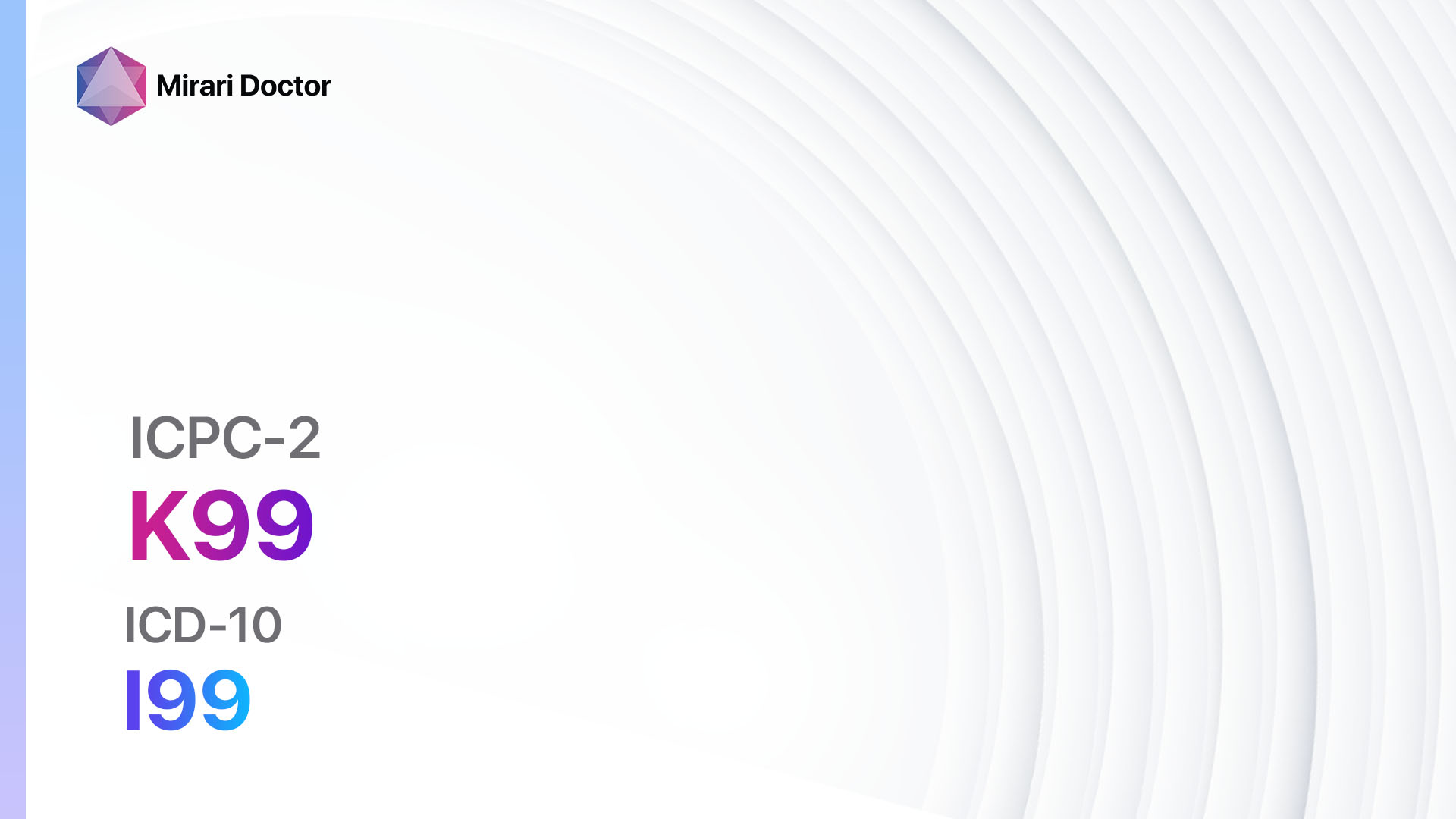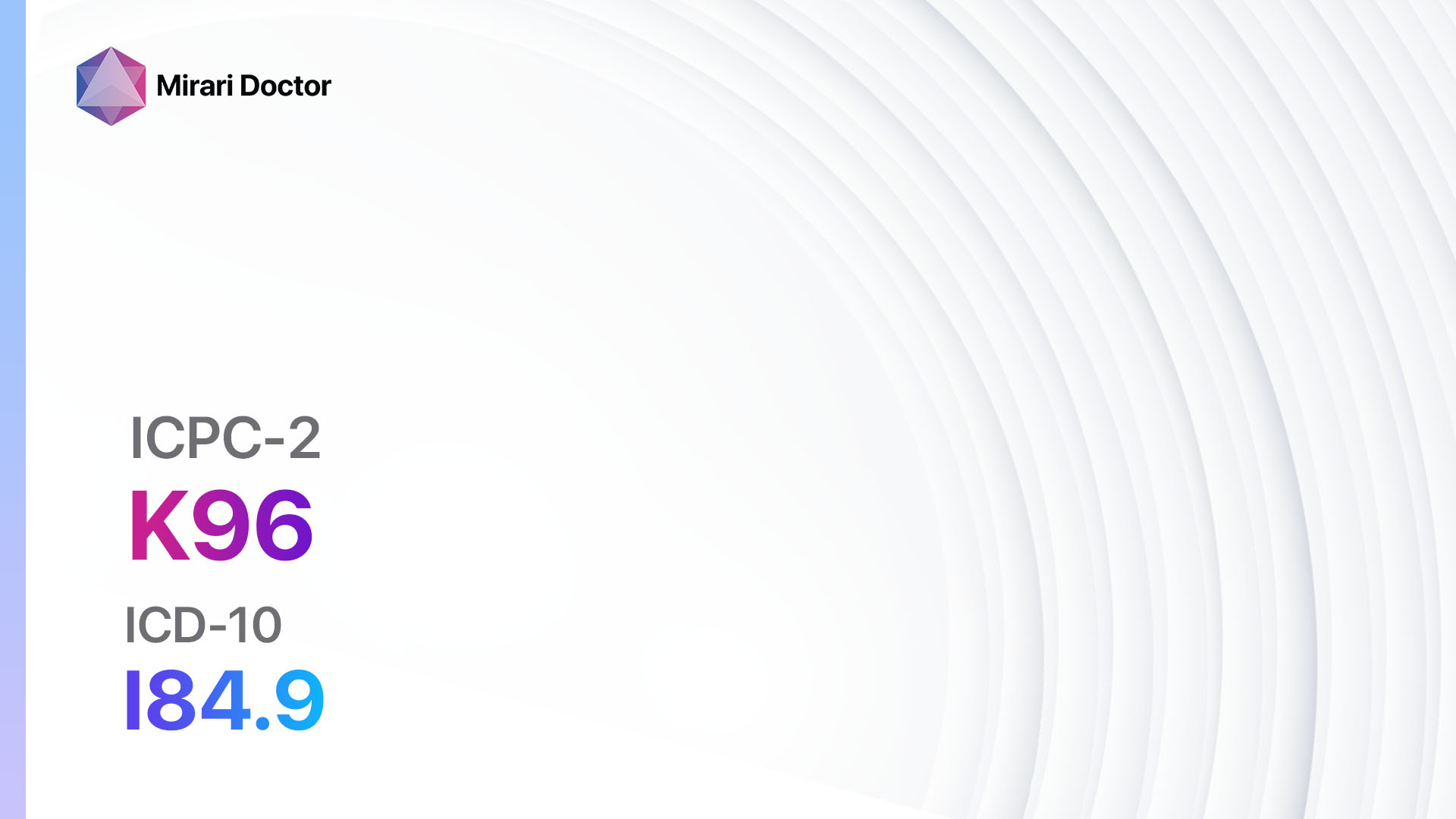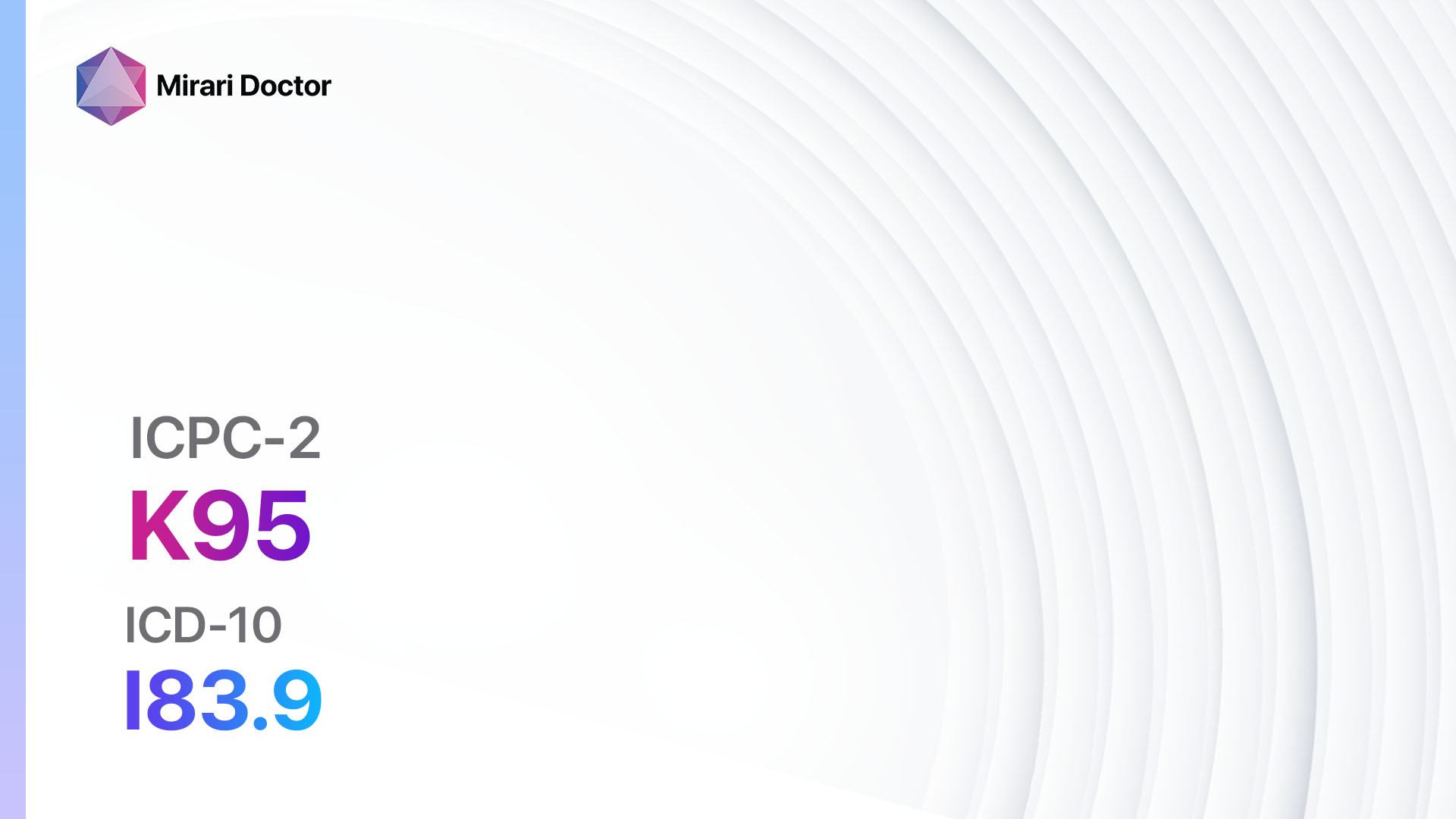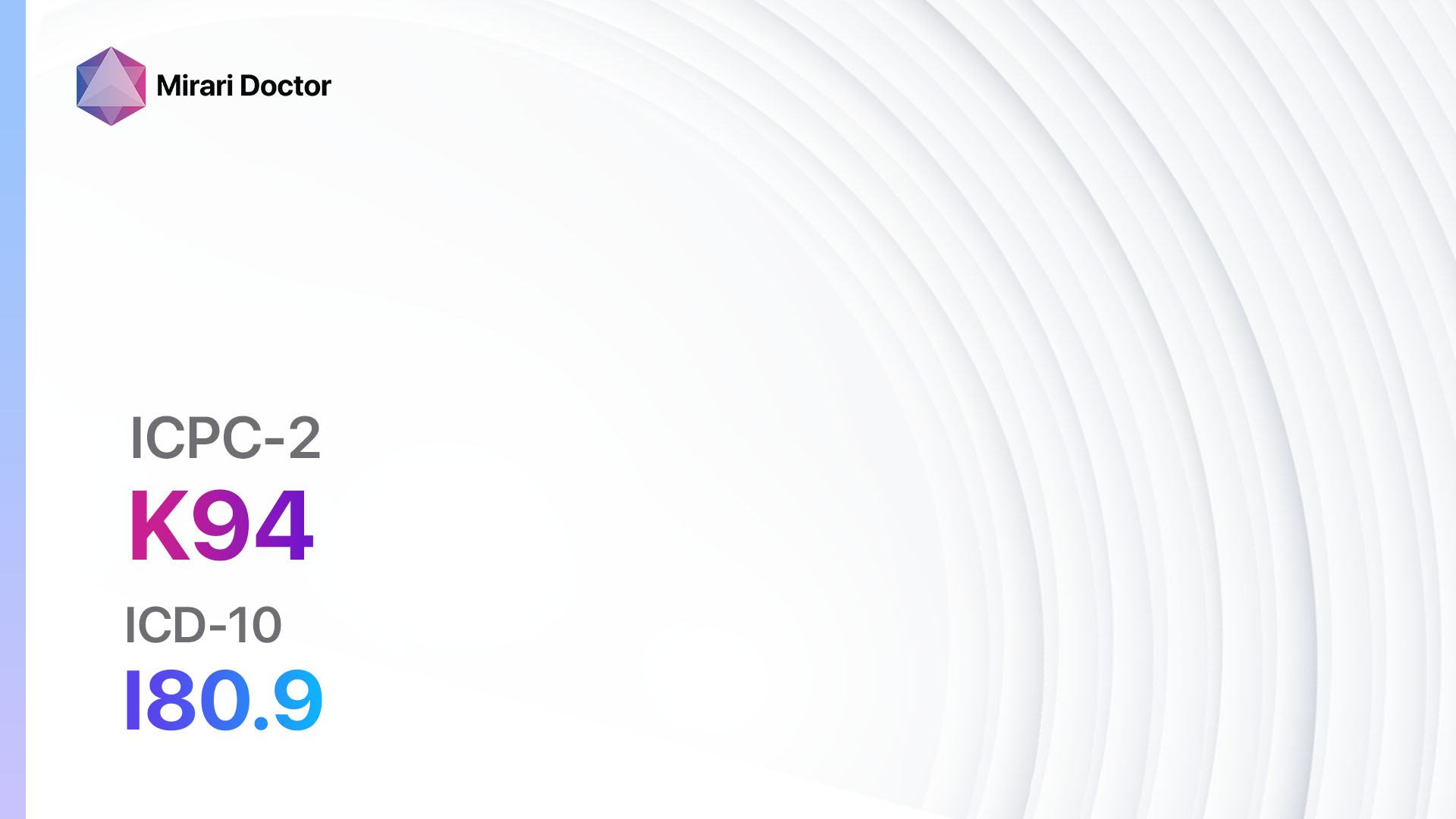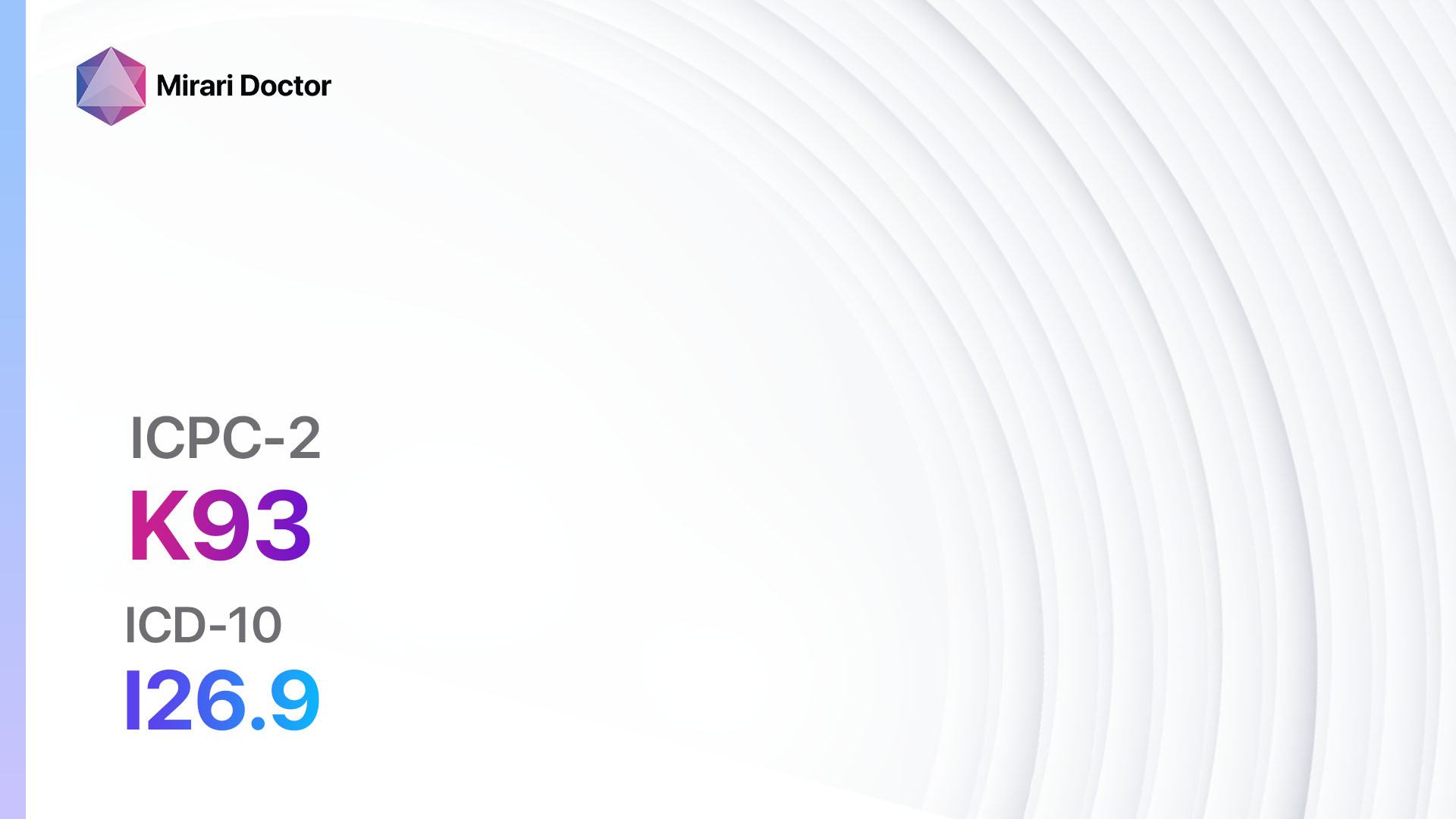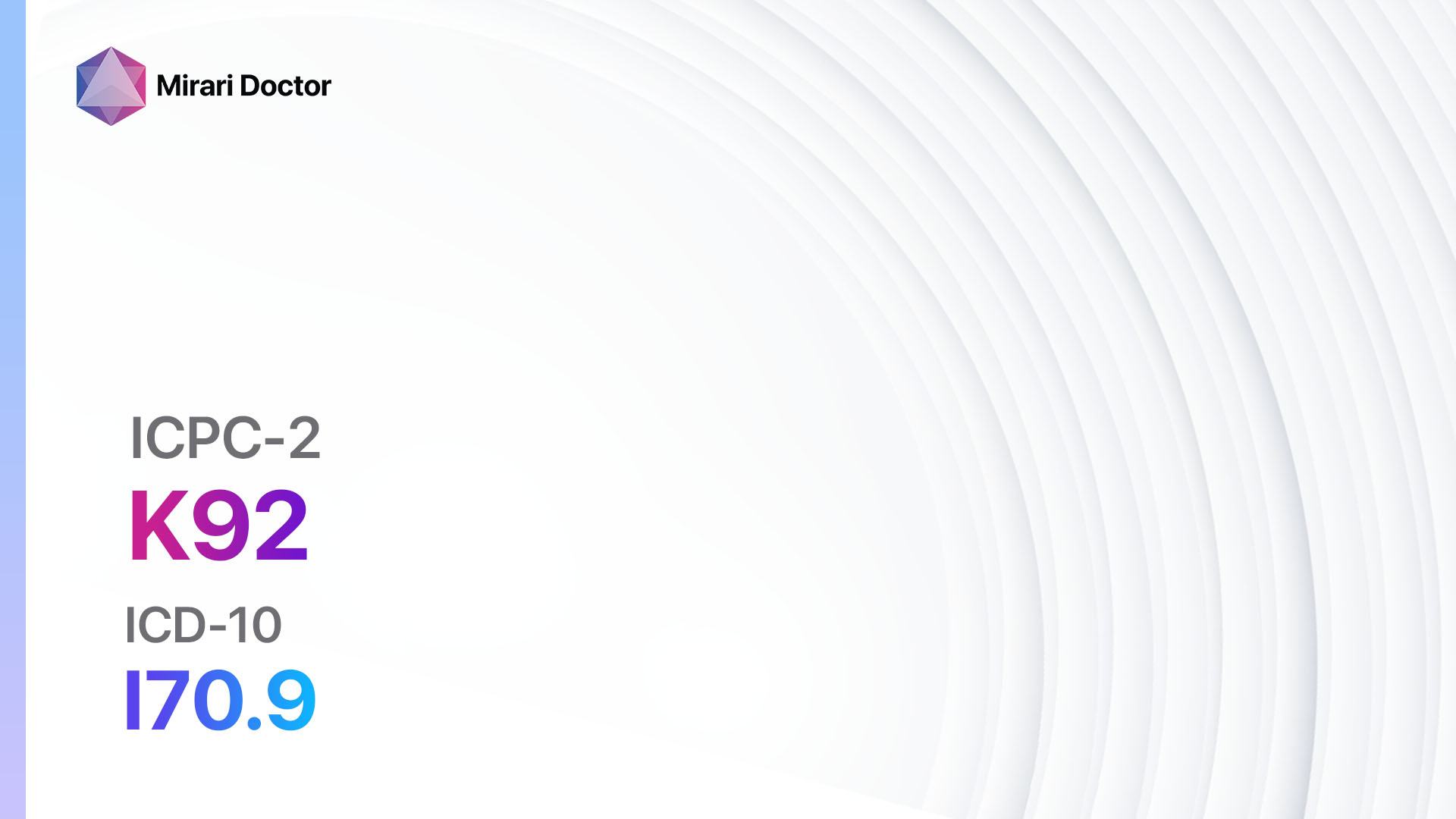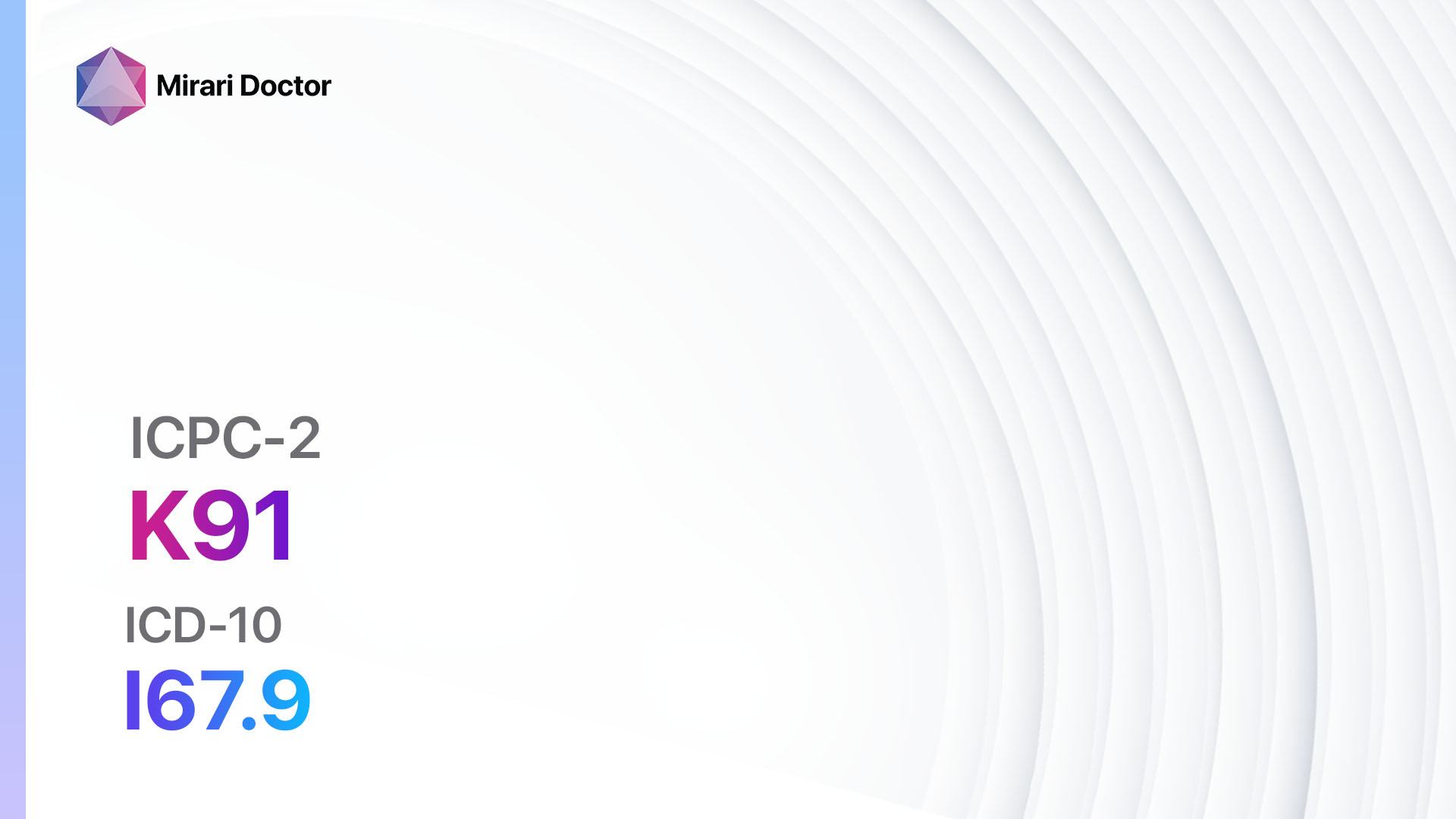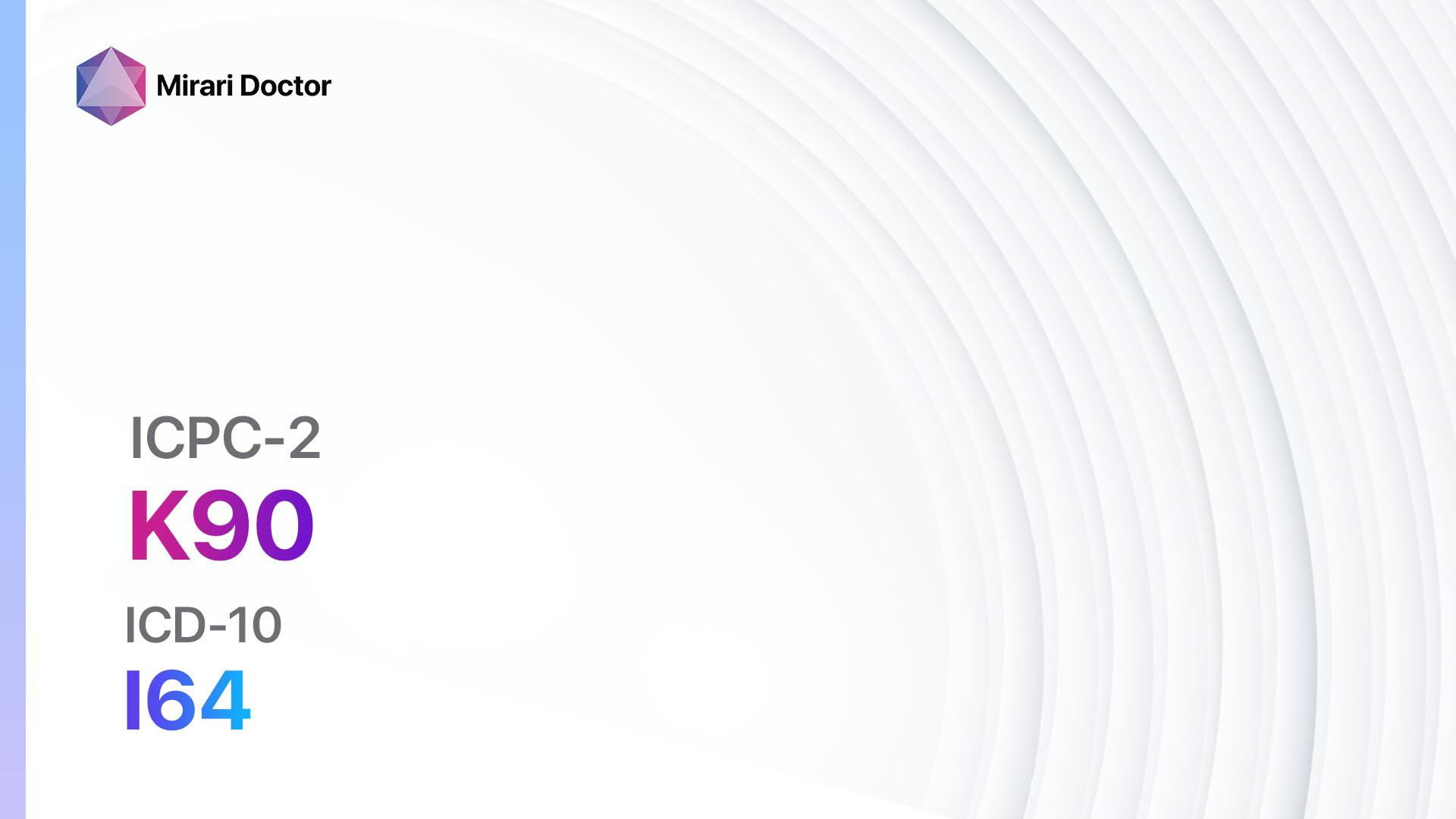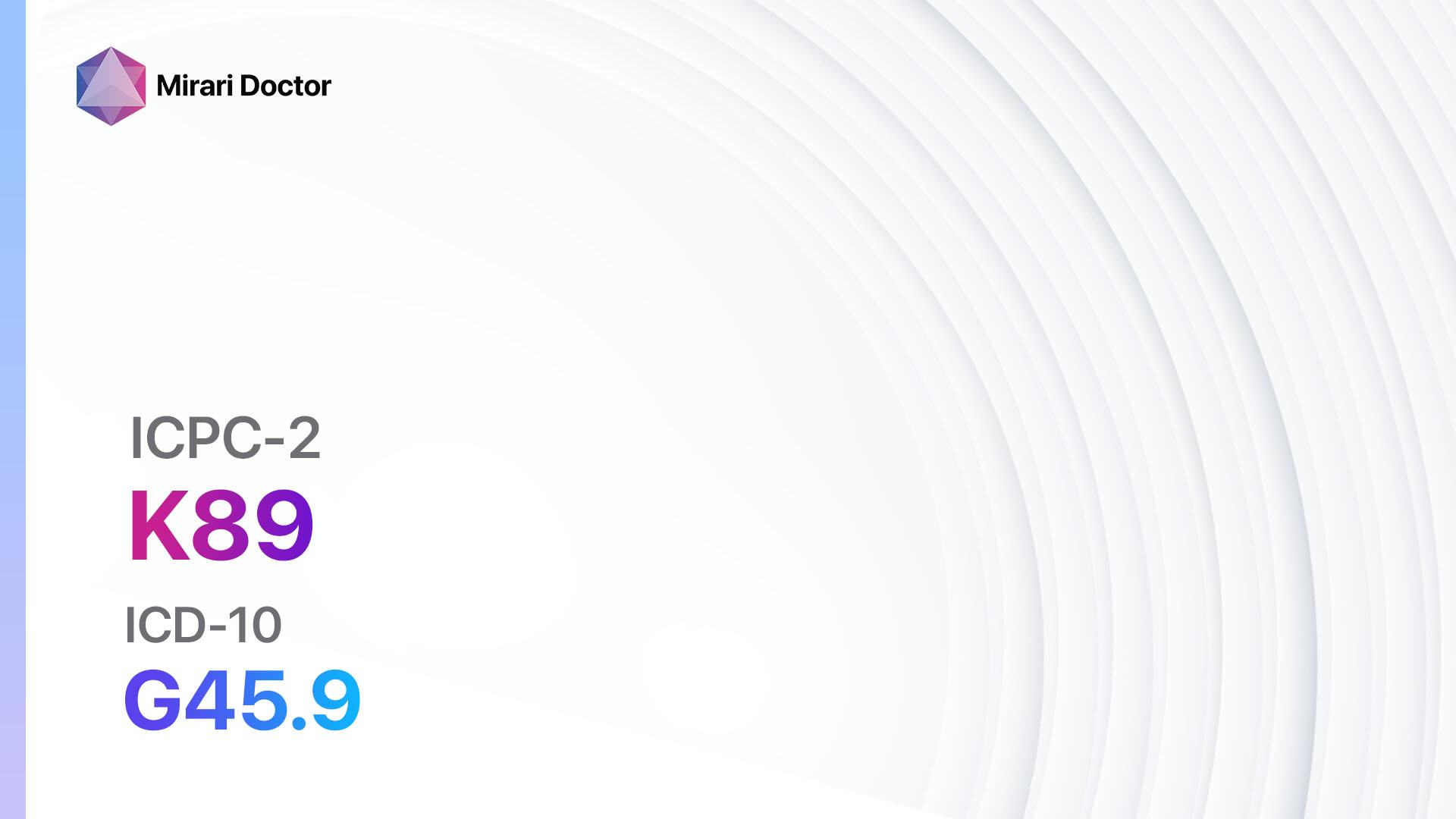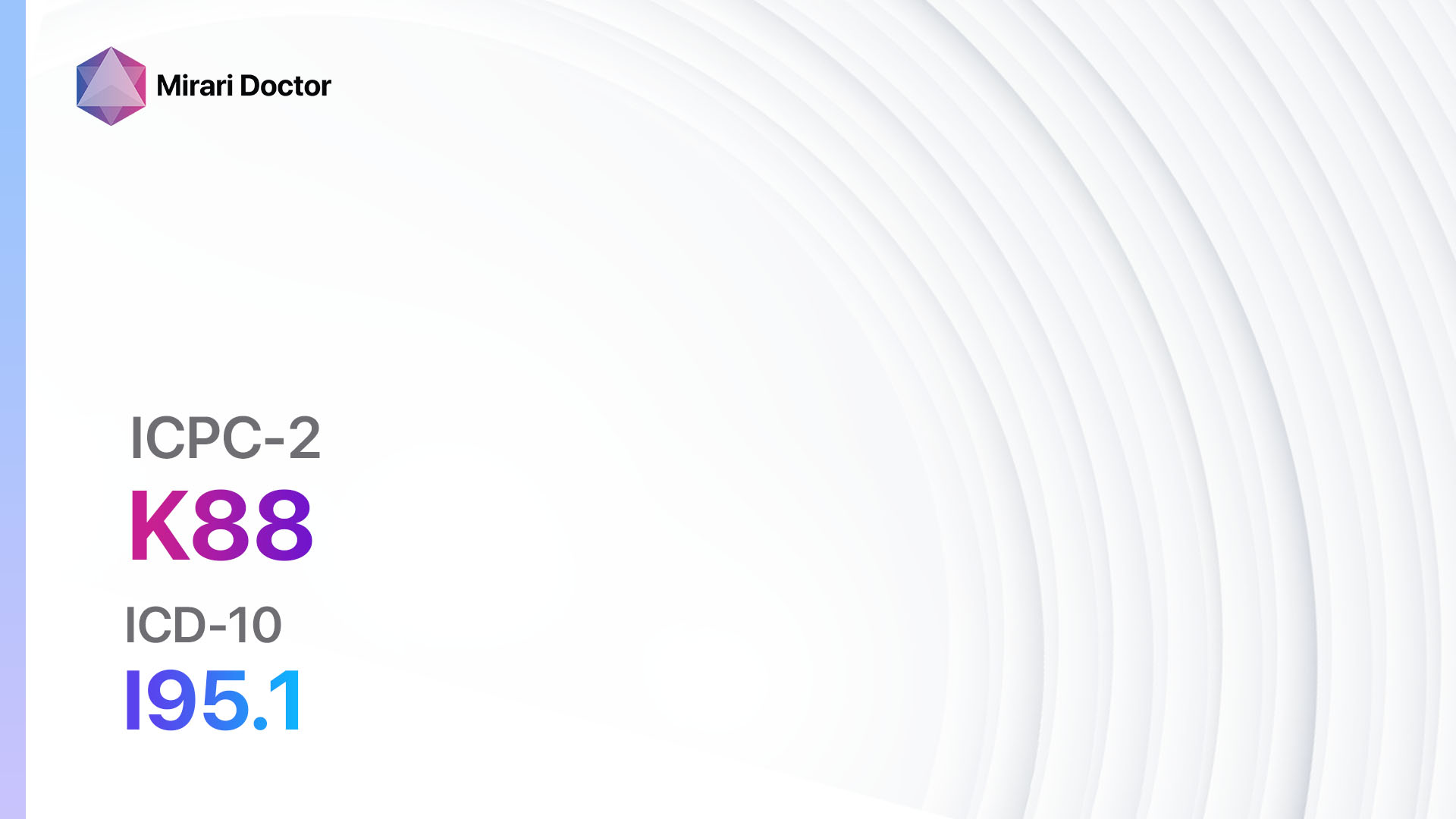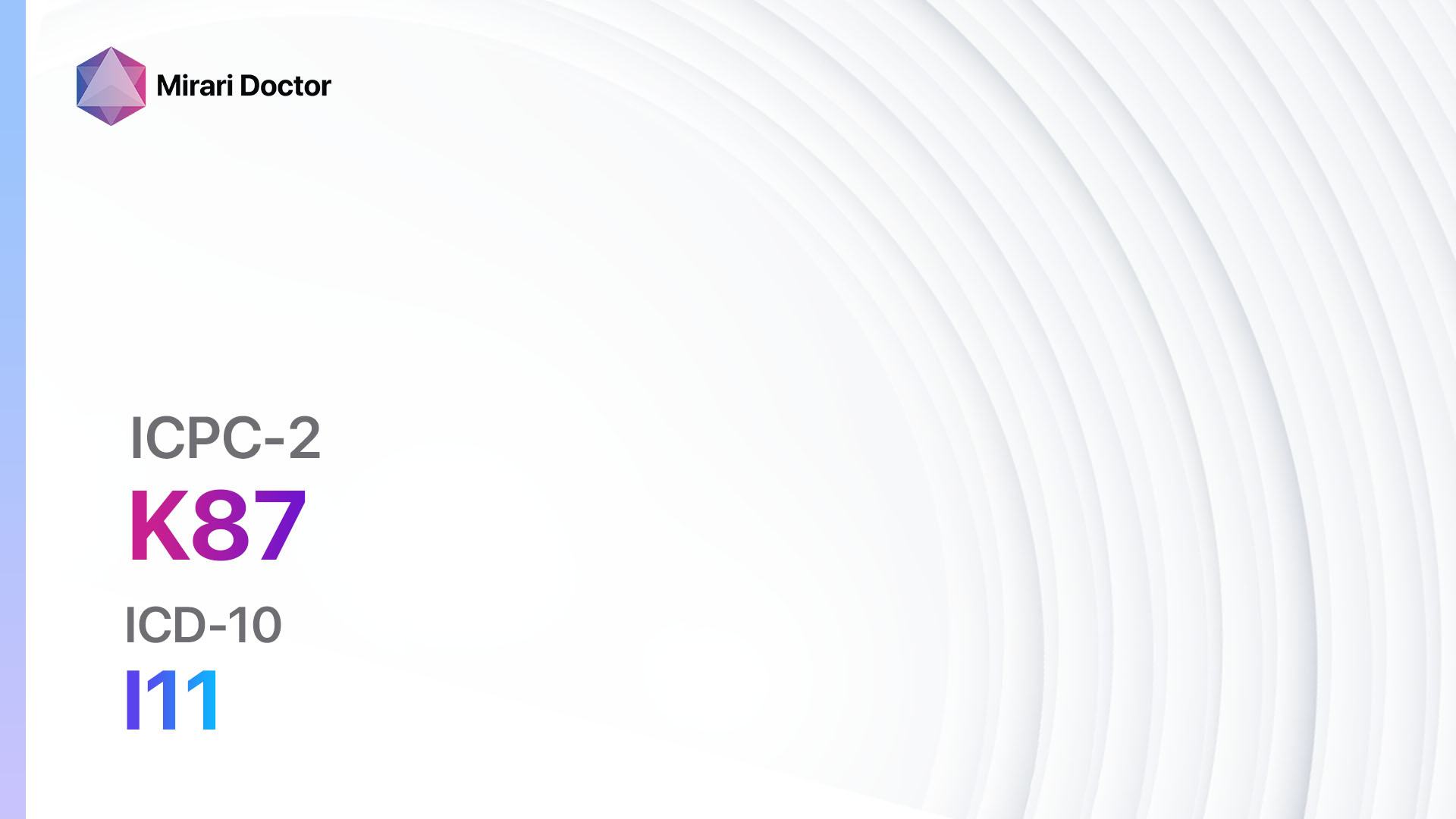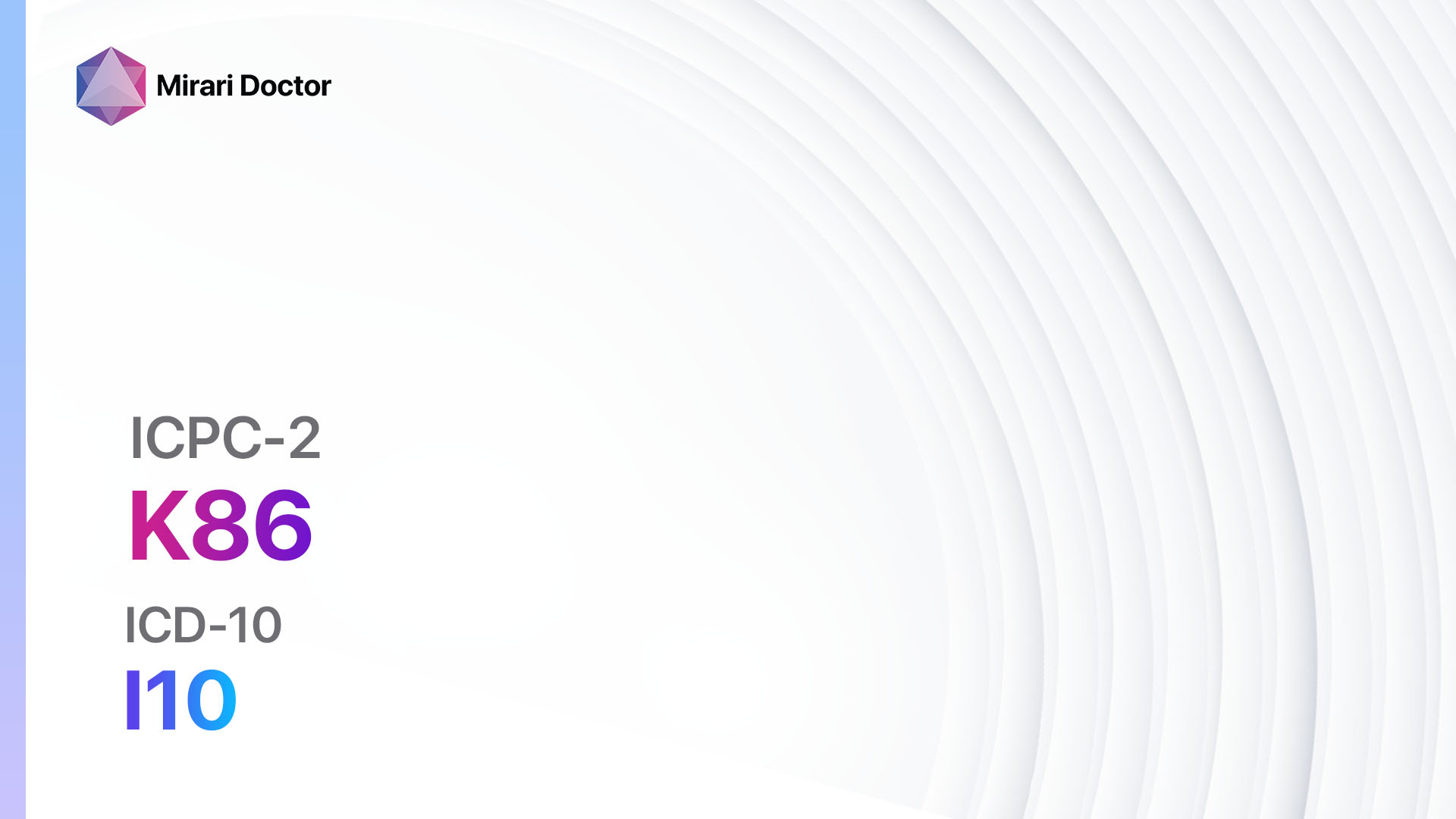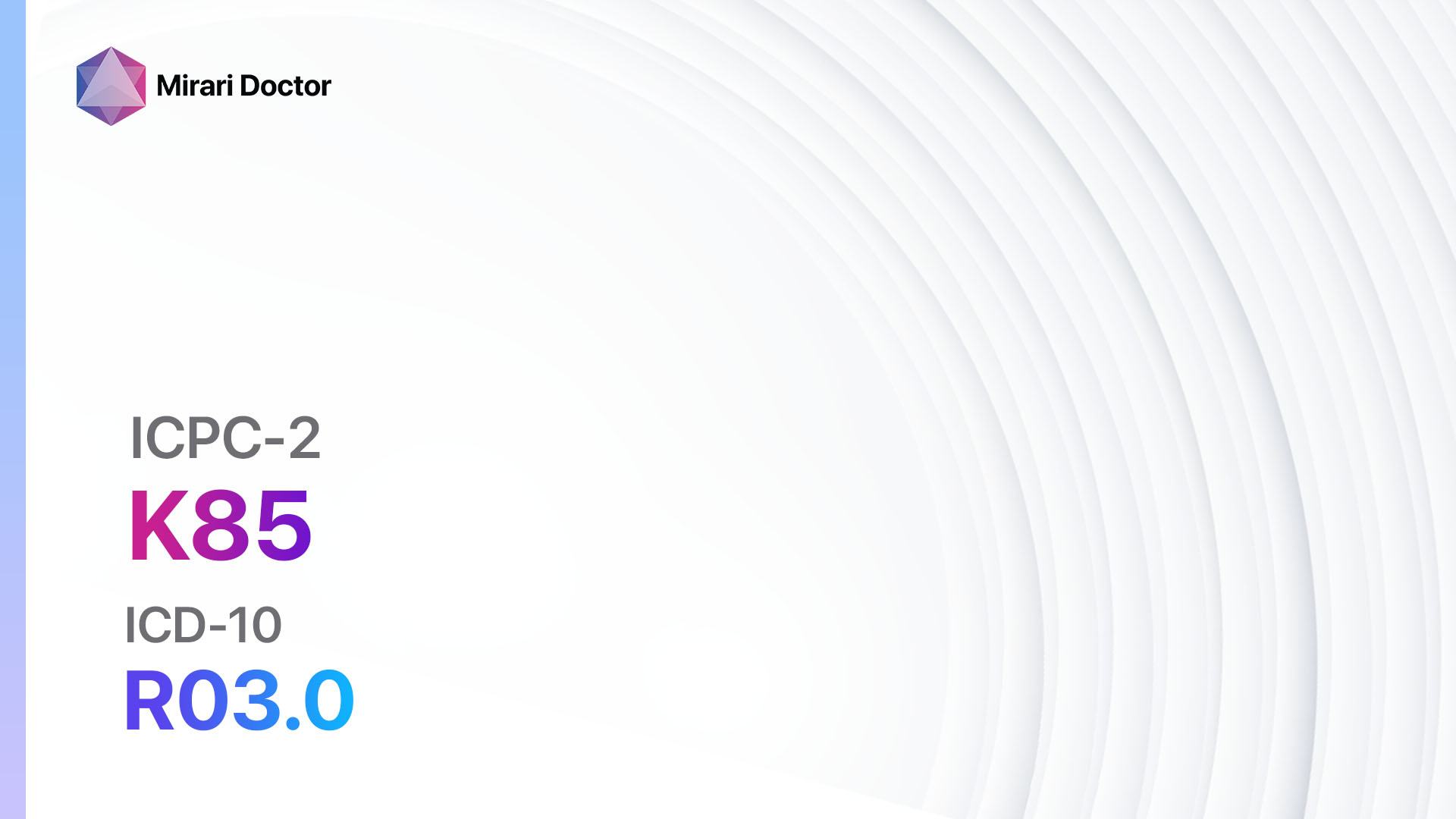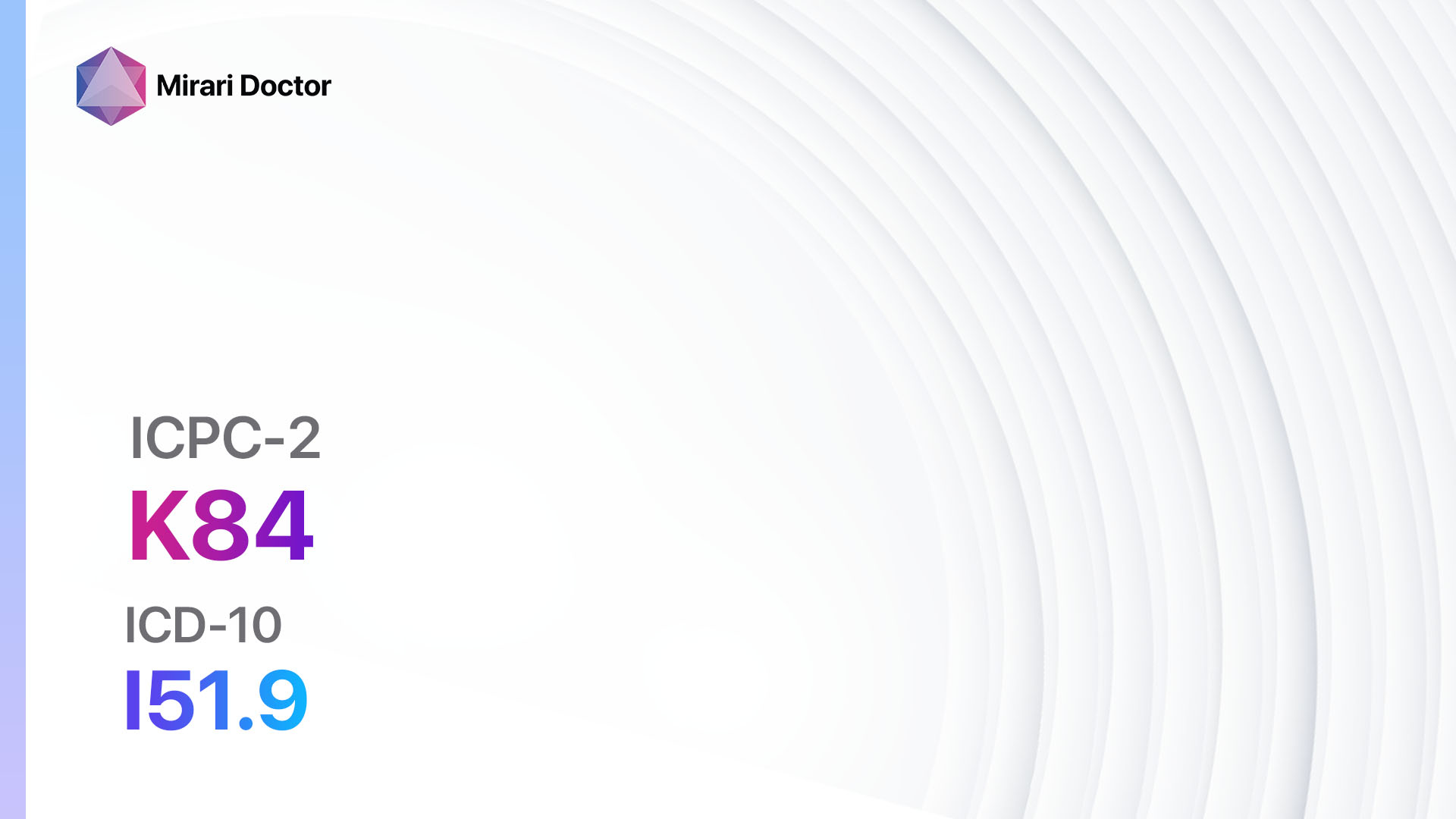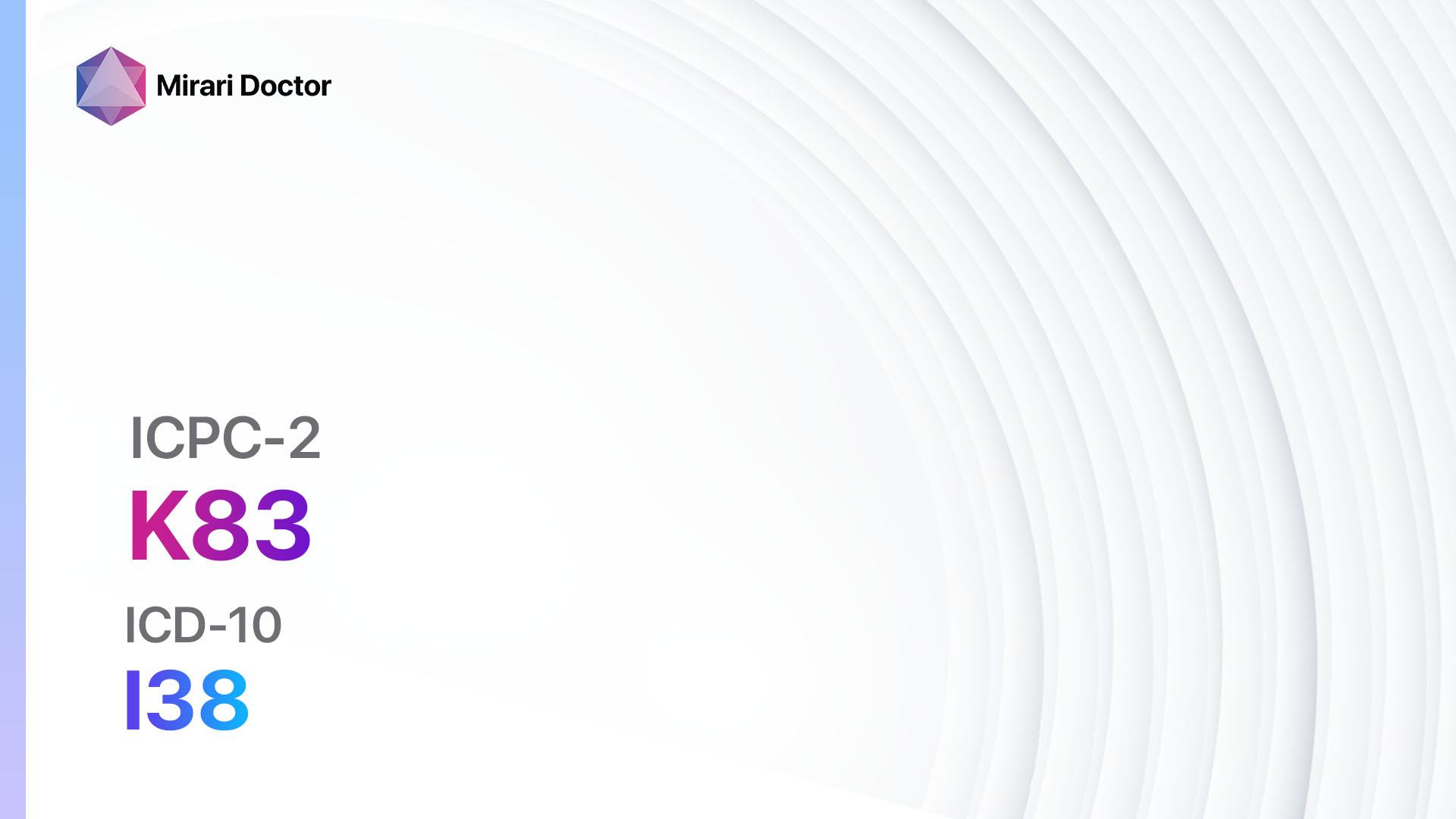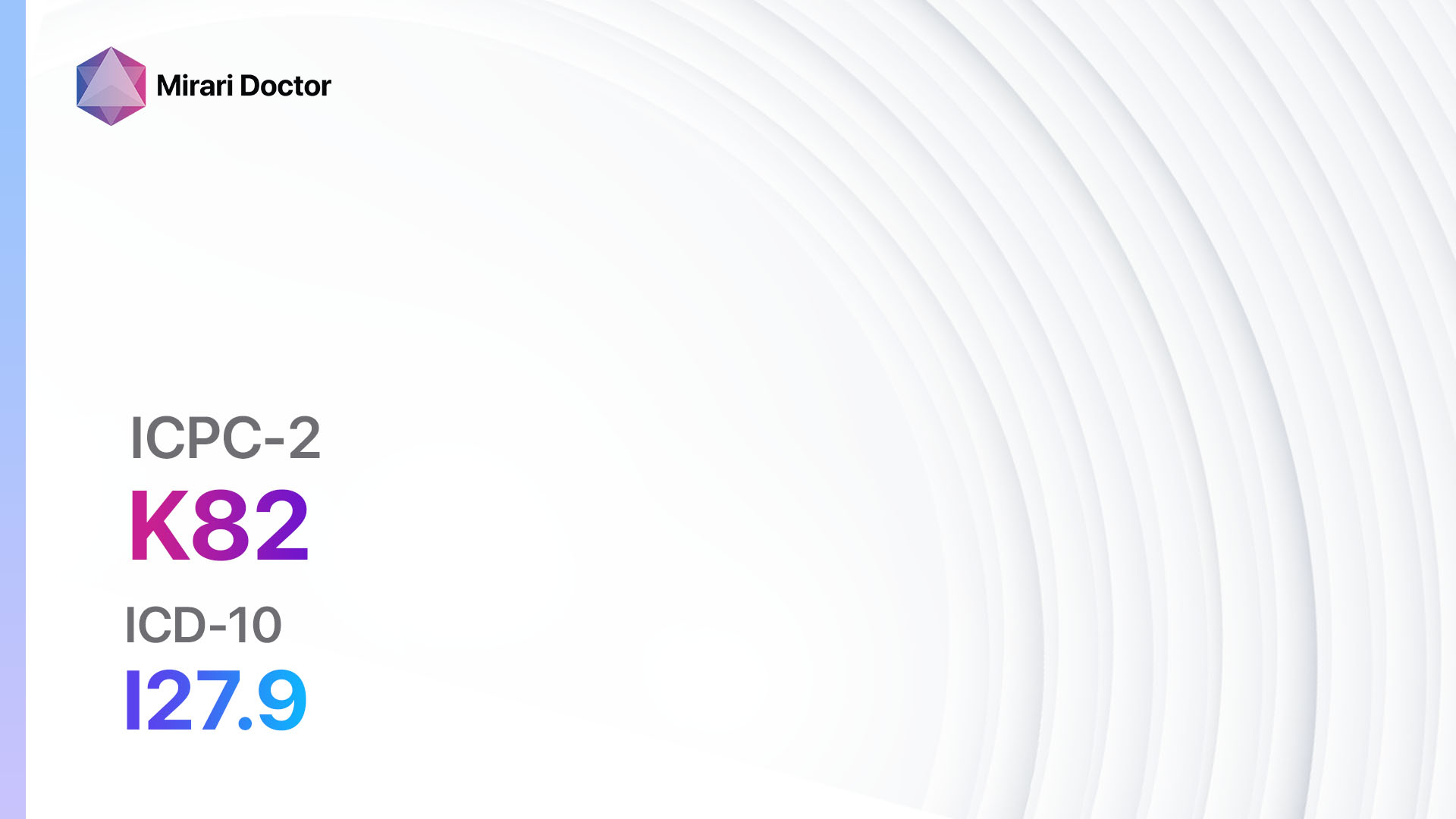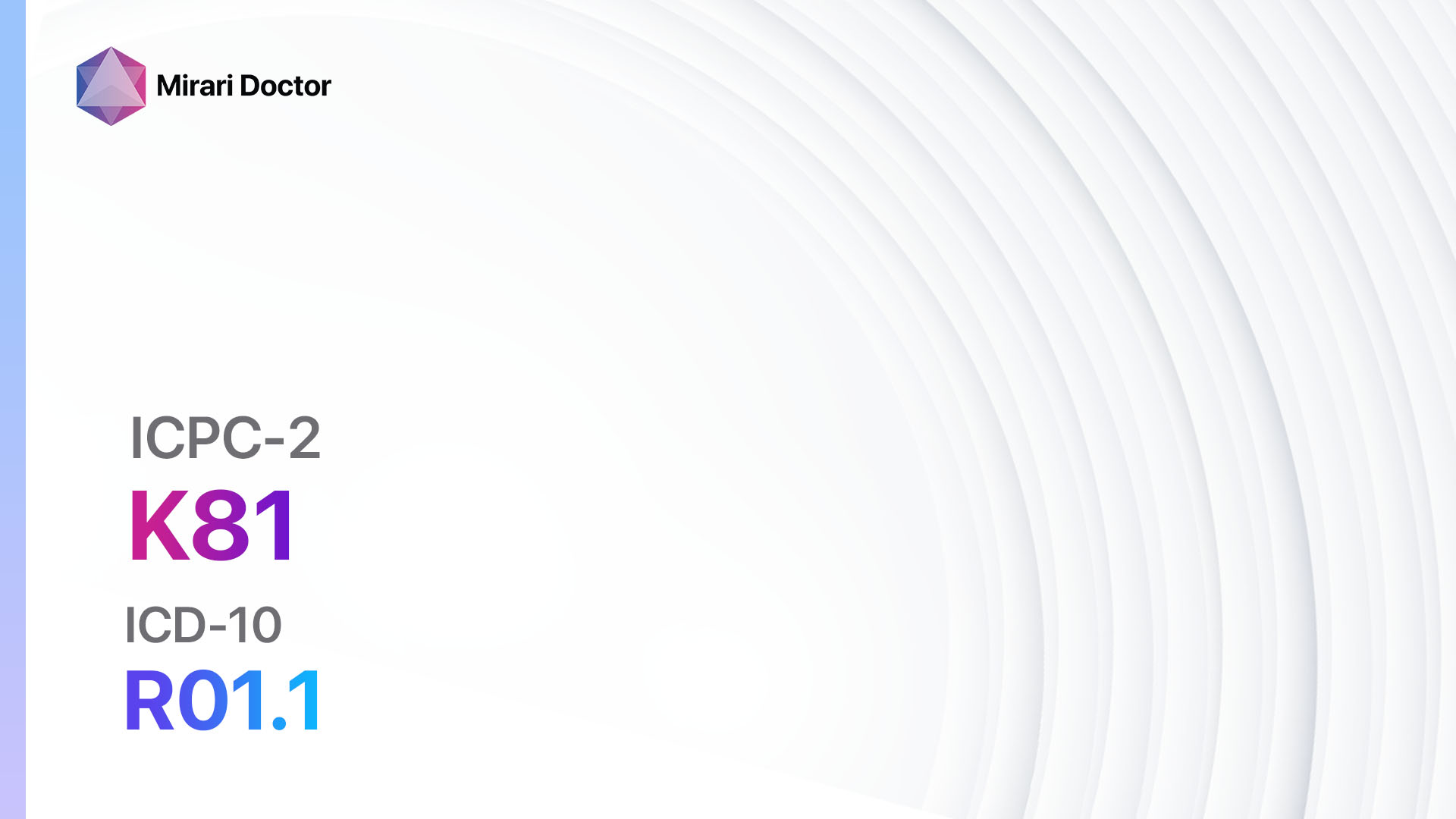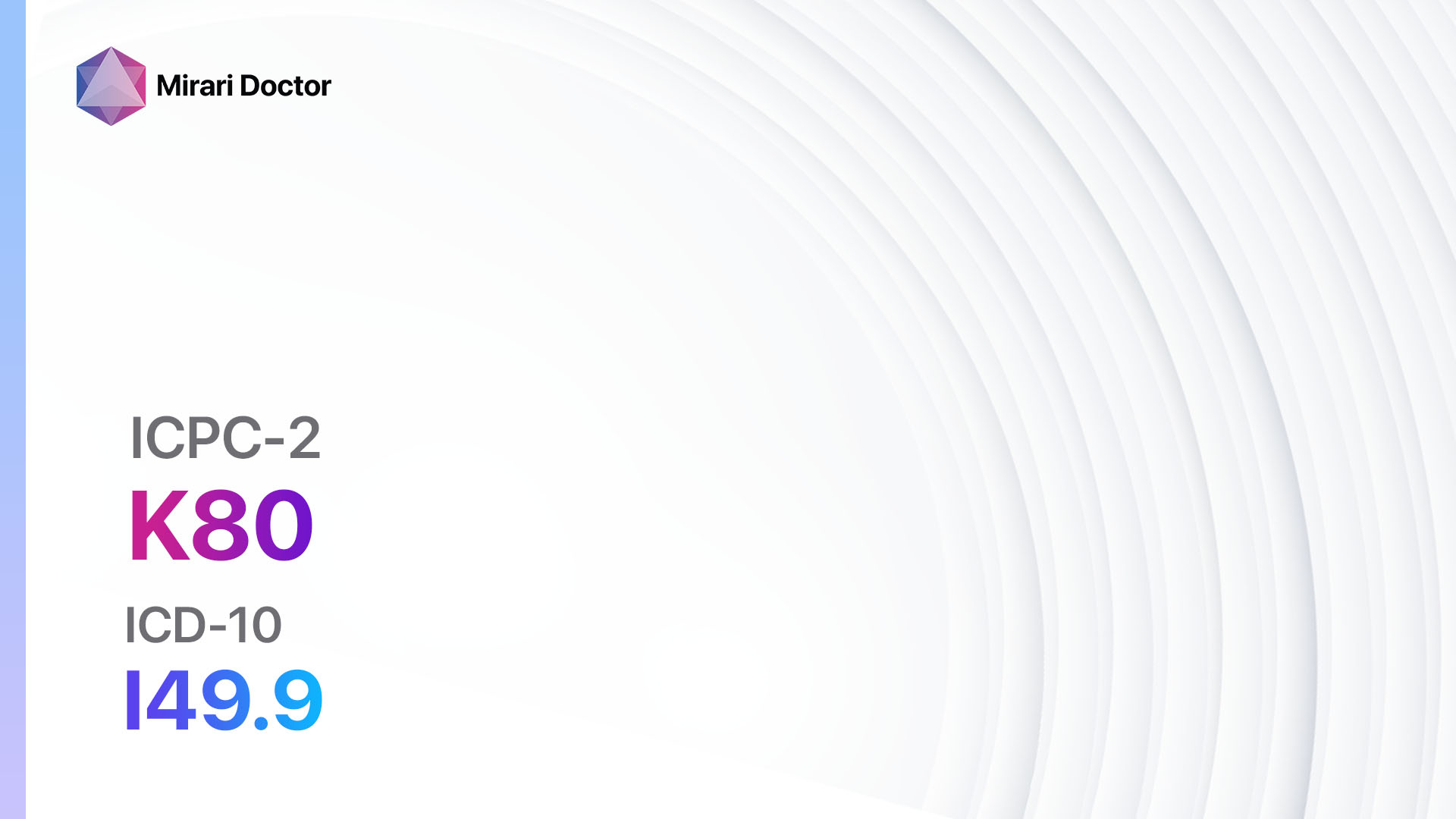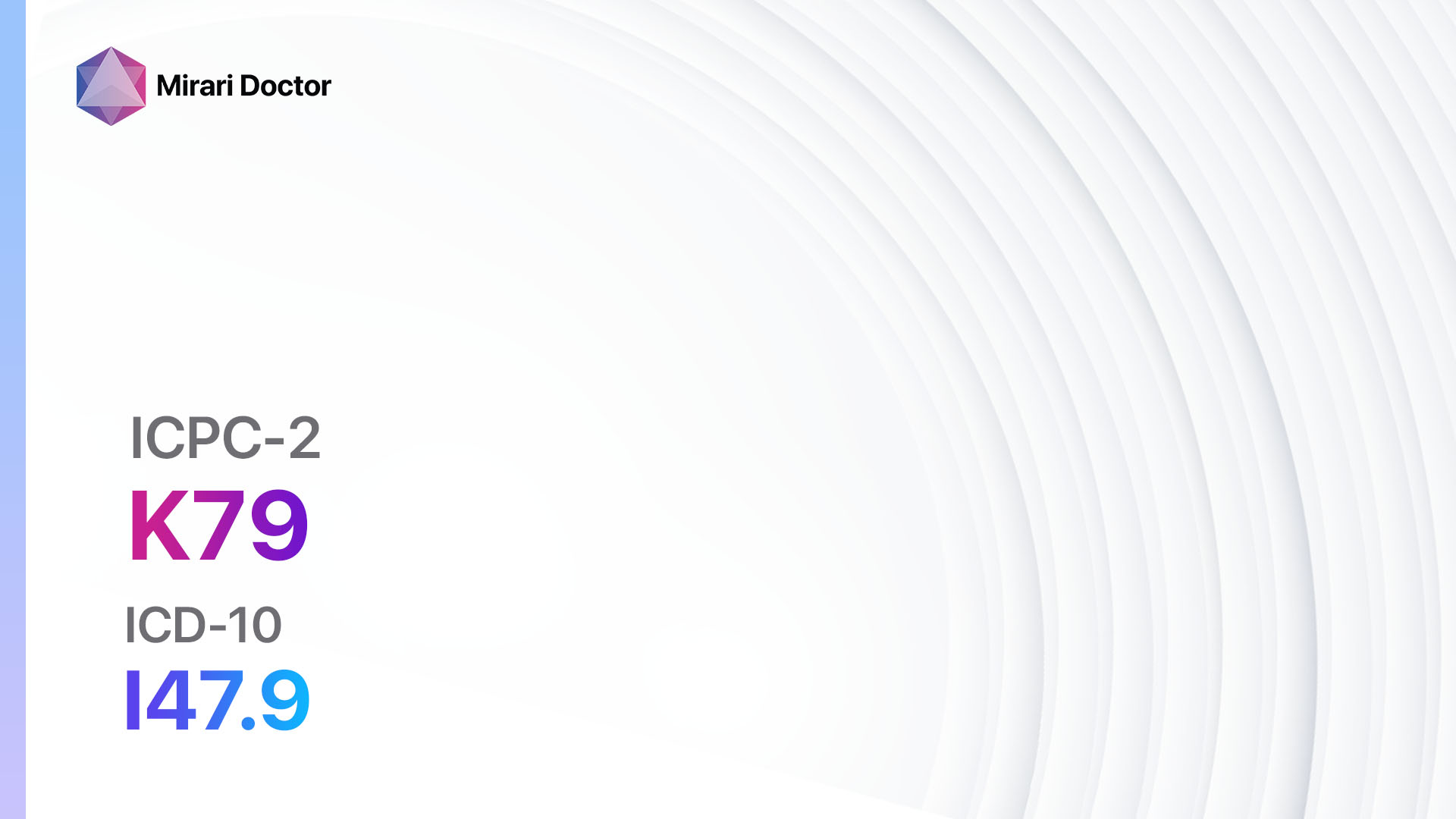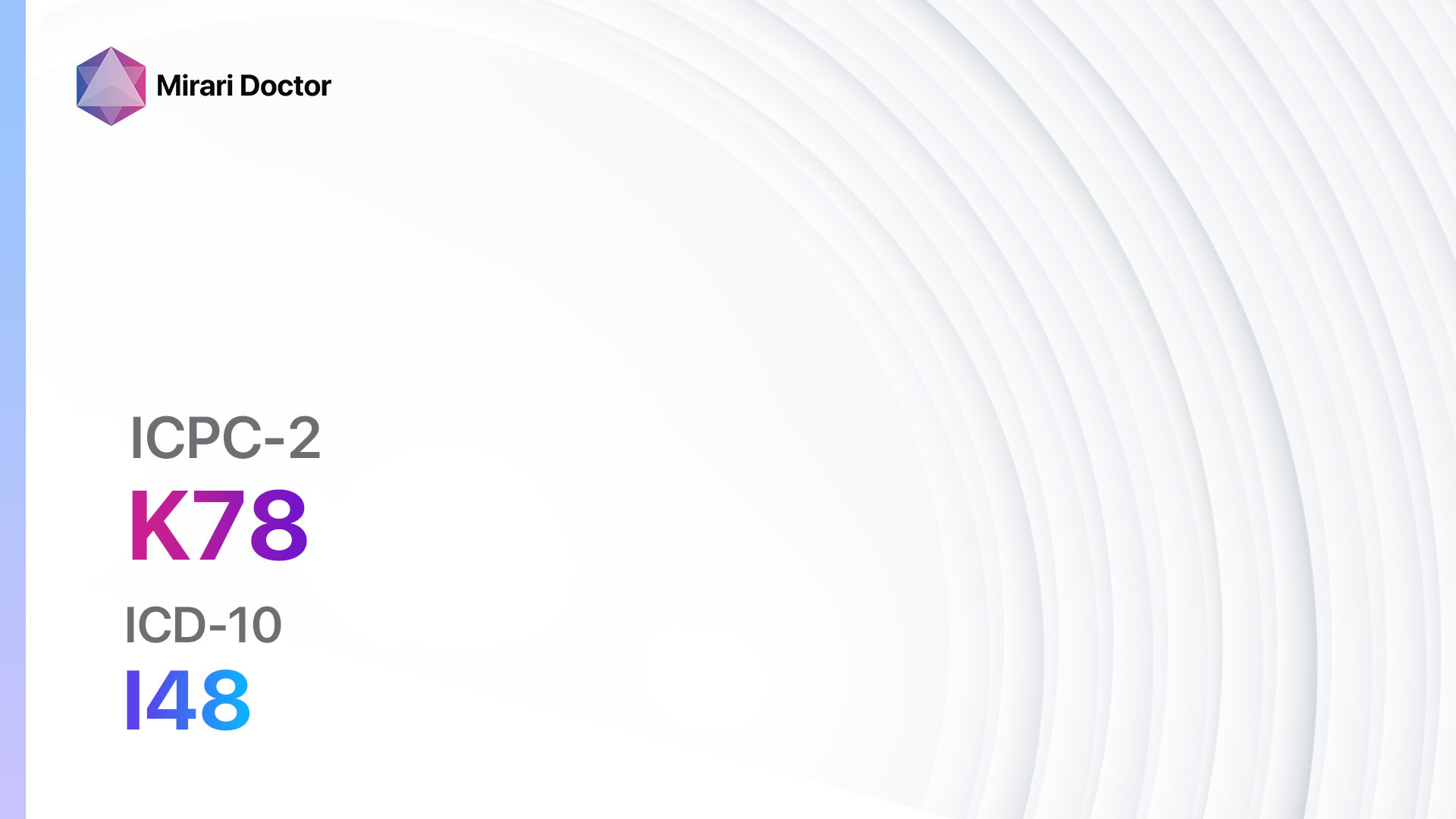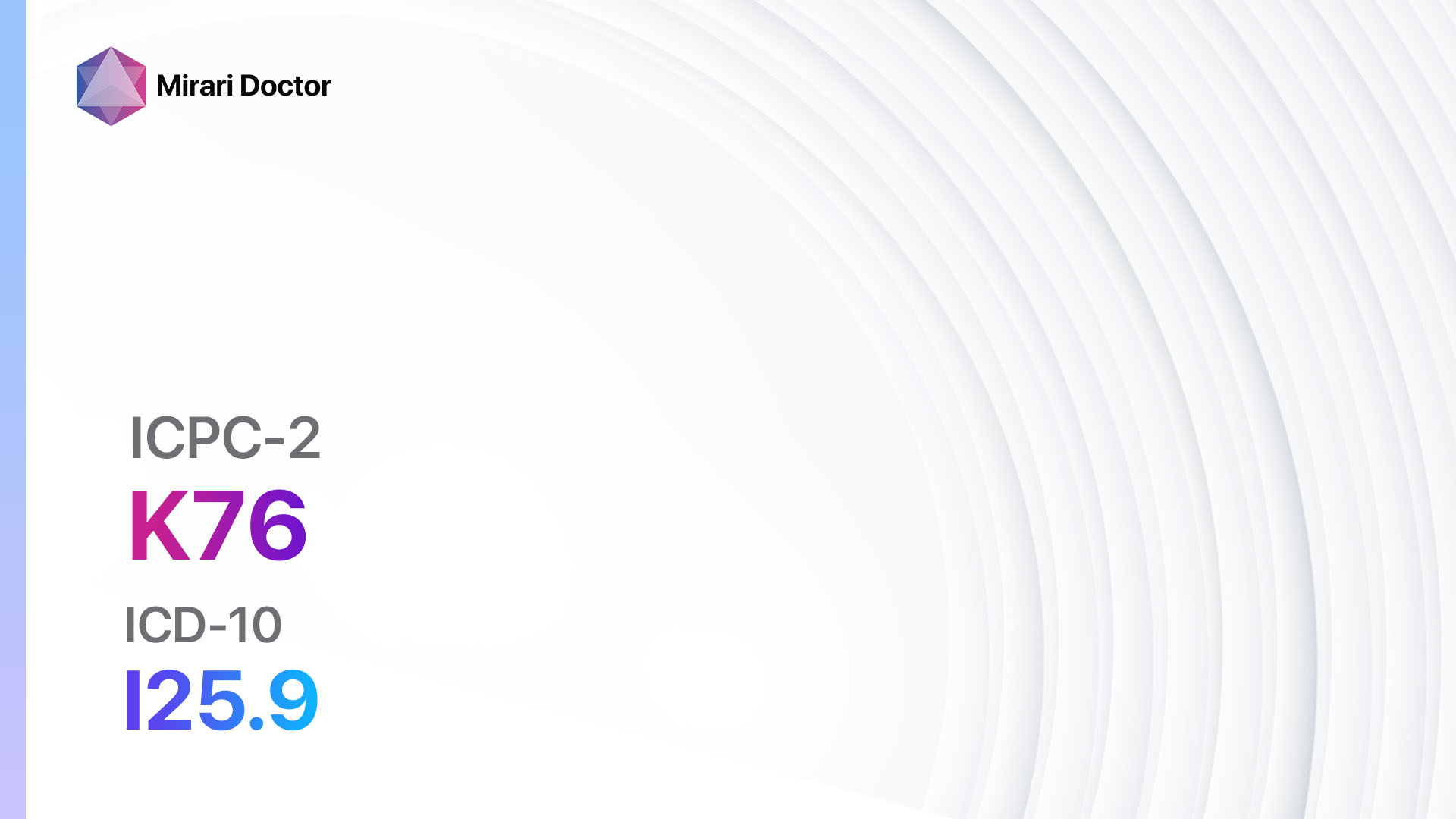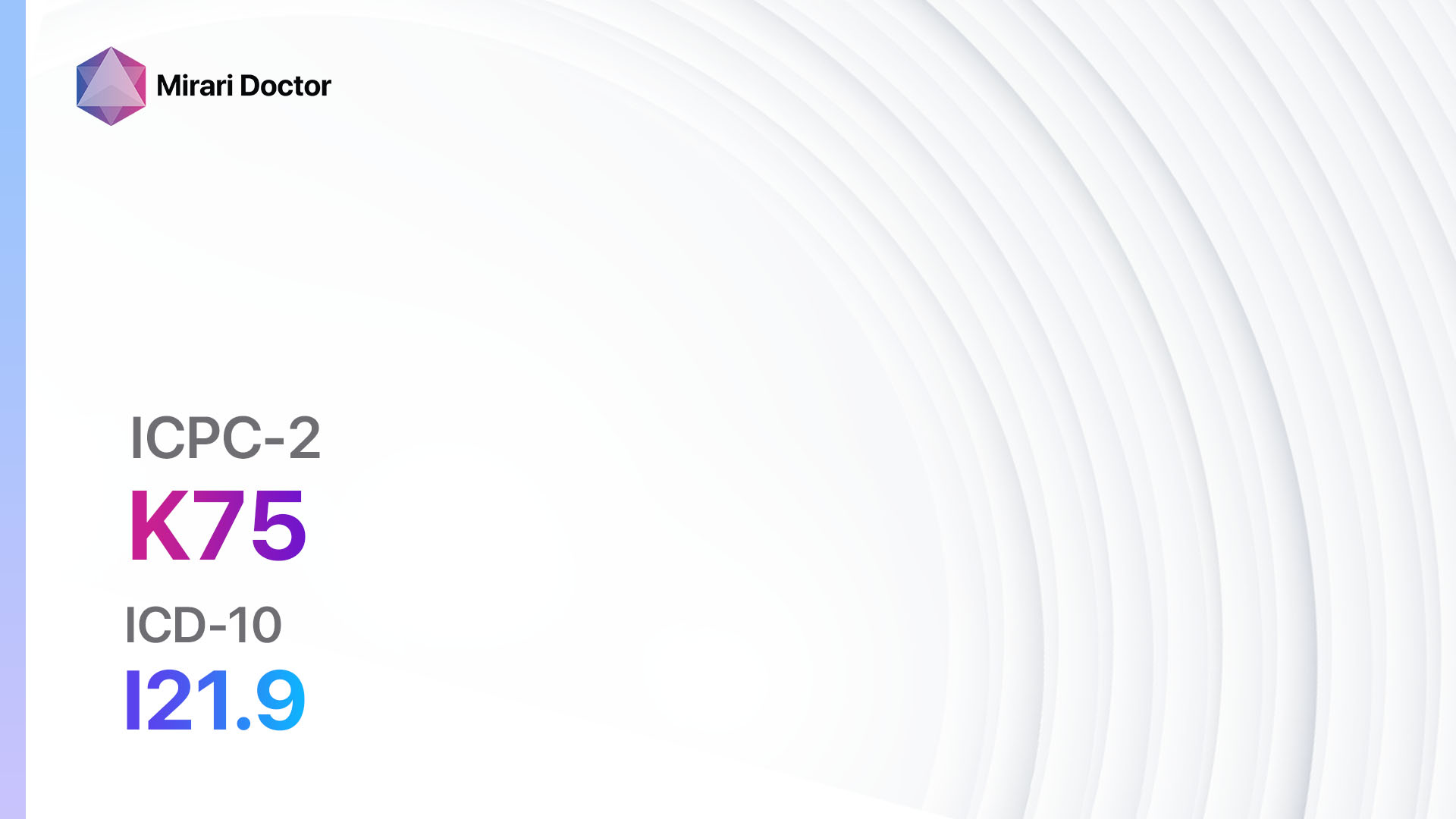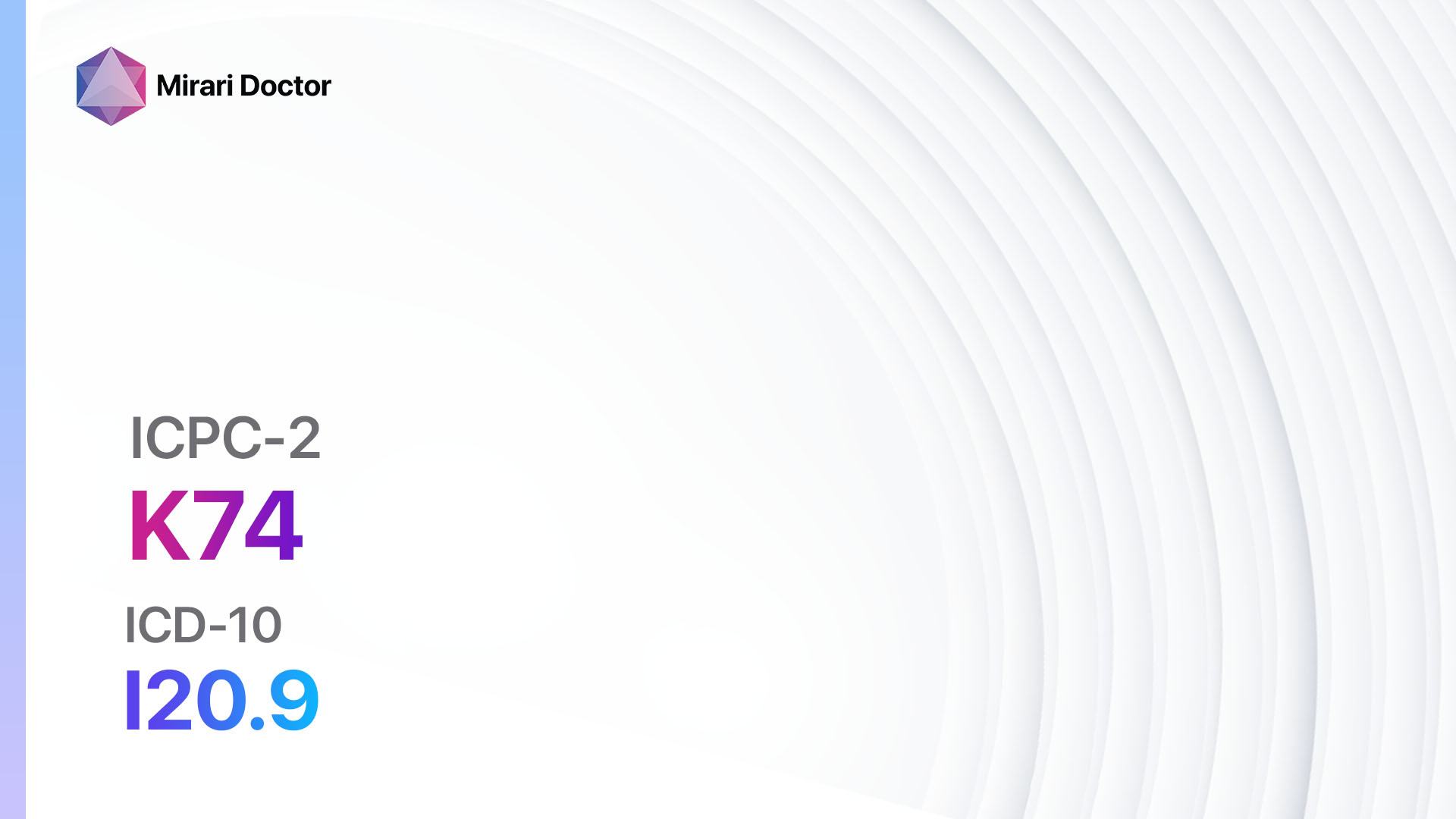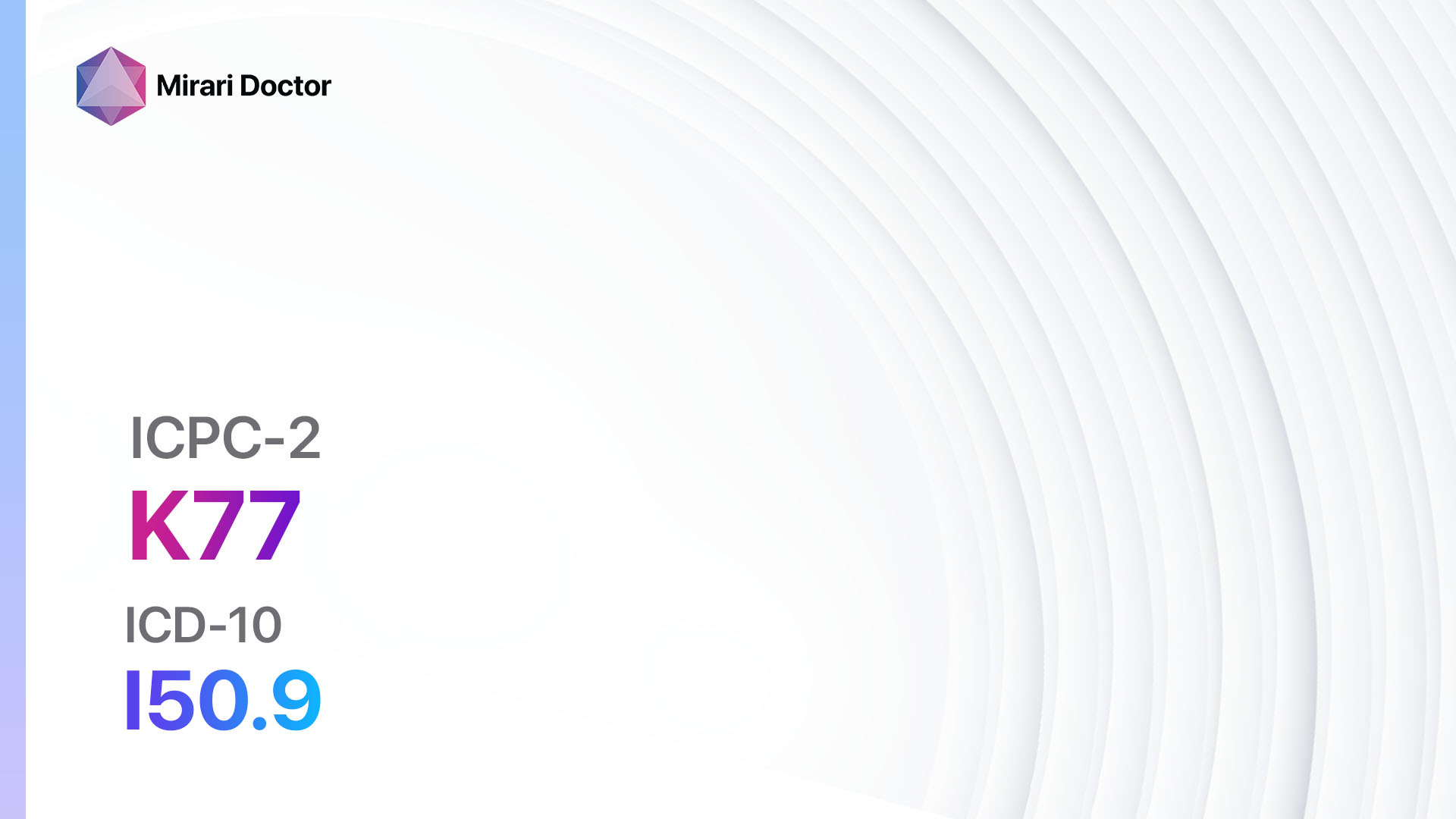
Introduction
Heart failure is a chronic condition in which the heart is unable to pump enough blood to meet the body’s needs. It can be caused by various underlying conditions and can lead to significant morbidity and mortality[1]. The aim of this guide is to provide a comprehensive overview of heart failure, including its symptoms, causes, diagnostic steps, possible interventions, and lifestyle modifications.
Codes
Symptoms
- Fatigue: Feeling tired or weak, especially with physical exertion[2].
- Shortness of breath: Difficulty breathing, especially during exercise or when lying flat[3].
- Swelling: Edema in the legs, ankles, feet, or abdomen[4].
- Rapid or irregular heartbeat: Palpitations or arrhythmias[5].
- Persistent cough or wheezing: Coughing that produces white or pink blood-tinged mucus[6].
- Reduced ability to exercise: Decreased tolerance for physical activity[7].
- Sudden weight gain: Rapid weight gain over a few days due to fluid retention[8].
- Loss of appetite: Decreased desire to eat or feeling full quickly[9].
Causes
- Coronary artery disease: Narrowing or blockage of the arteries that supply blood to the heart muscle[10].
- High blood pressure: Increased pressure in the arteries, forcing the heart to work harder.
- Cardiomyopathy: Disease of the heart muscle, leading to weakened pumping ability.
- Heart valve problems: Malfunctioning or damaged heart valves.
- Congenital heart defects: Structural abnormalities present at birth.
- Arrhythmias: Abnormal heart rhythms.
- Other conditions: Diabetes, thyroid disorders, obesity, lung diseases, kidney diseases, and certain medications.
Diagnostic Steps
Medical History
- Gather information about the patient’s symptoms, including their duration, severity, and any triggers or alleviating factors.
- Assess the patient’s medical history, including any previous heart conditions, surgeries, or hospitalizations.
- Identify risk factors for heart failure, such as a family history of heart disease, smoking, obesity, and sedentary lifestyle.
- Inquire about the patient’s current medications, as some drugs can contribute to heart failure.
Physical Examination
- Measure blood pressure, heart rate, and respiratory rate.
- Auscultate the heart and lungs for abnormal sounds, such as murmurs or crackles.
- Palpate the extremities for edema or swelling.
- Assess the jugular venous pressure, which can be elevated in heart failure.
- Check for signs of fluid retention, such as ascites or hepatomegaly.
Laboratory Tests
- Complete blood count (CBC): To assess for anemia or infection.
- Basic metabolic panel (BMP): To evaluate kidney and liver function, electrolyte levels, and blood glucose.
- B-type natriuretic peptide (BNP) or N-terminal pro-BNP (NT-proBNP): Elevated levels indicate heart failure.
- Lipid profile: To assess cholesterol levels and evaluate cardiovascular risk.
- Thyroid function tests: To rule out thyroid disorders as a cause of heart failure.
- Urinalysis: To check for proteinuria or other signs of kidney dysfunction.
Diagnostic Imaging
- Chest X-ray: To evaluate the size and shape of the heart, as well as the presence of fluid in the lungs.
- Echocardiogram: To assess the structure and function of the heart, including ejection fraction.
- Electrocardiogram (ECG): To detect abnormal heart rhythms or signs of previous heart attacks.
- Stress test: To evaluate the heart’s response to exercise and assess exercise tolerance.
- Cardiac MRI or CT scan: To provide detailed images of the heart and blood vessels.
- Coronary angiography: To visualize the coronary arteries and identify blockages.
Other Tests
- Cardiac catheterization: To measure pressures within the heart and assess coronary artery blockages.
- Endomyocardial biopsy: To obtain a small sample of heart tissue for analysis in certain cases.
- Genetic testing: To identify specific genetic mutations associated with certain types of cardiomyopathy.
Follow-up and Patient Education
- Schedule regular follow-up appointments to monitor the patient’s condition and adjust treatment as needed.
- Educate the patient about heart failure, its causes, and the importance of adhering to the prescribed treatment plan.
- Provide information on lifestyle modifications, including dietary changes, exercise recommendations, and smoking cessation.
- Discuss the signs and symptoms of worsening heart failure and when to seek medical attention.
- Address any questions or concerns the patient may have about their condition or treatment.
Possible Interventions
Traditional Interventions
Medications:
Top 5 drugs for Heart failure:
- Angiotensin-converting enzyme (ACE) inhibitors (e.g., Lisinopril, Enalapril):
- Cost: Generic versions can be $10-$50/month.
- Contraindications: History of angioedema with ACE inhibitors, bilateral renal artery stenosis.
- Side effects: Cough, dizziness, hyperkalemia.
- Severe side effects: Angioedema, renal failure.
- Drug interactions: Potassium-sparing diuretics, nonsteroidal anti-inflammatory drugs (NSAIDs).
- Warning: Monitoring of renal function and potassium levels is required.
- Beta-blockers (e.g., Carvedilol, Metoprolol):
- Cost: Generic versions are typically <$30/month.
- Contraindications: Severe bradycardia, heart block, decompensated heart failure.
- Side effects: Fatigue, dizziness, bradycardia.
- Severe side effects: Bronchospasm, heart block.
- Drug interactions: Calcium channel blockers, insulin.
- Warning: Should not be abruptly stopped.
- Diuretics (e.g., Furosemide, Hydrochlorothiazide):
- Cost: Generic versions can be <$10/month.
- Contraindications: Anuria, severe electrolyte imbalance.
- Side effects: Frequent urination, electrolyte abnormalities.
- Severe side effects: Dehydration, hypotension.
- Drug interactions: Nonsteroidal anti-inflammatory drugs (NSAIDs), lithium.
- Warning: Monitor electrolyte levels and renal function.
- Aldosterone antagonists (e.g., Spironolactone, Eplerenone):
- Cost: Generic versions can be $10-$50/month.
- Contraindications: Hyperkalemia, severe renal impairment.
- Side effects: Gynecomastia, hyperkalemia.
- Severe side effects: Renal failure, agranulocytosis.
- Drug interactions: Potassium supplements, angiotensin receptor blockers (ARBs).
- Warning: Monitor renal function and potassium levels.
- Digoxin:
- Cost: Generic versions can be <$10/month.
- Contraindications: Ventricular fibrillation, severe heart block.
- Side effects: Nausea, vomiting, arrhythmias.
- Severe side effects: Digoxin toxicity, visual disturbances.
- Drug interactions: Quinidine, verapamil.
- Warning: Monitor digoxin levels and renal function.
Alternative Drugs:
- Angiotensin receptor blockers (ARBs) (e.g., Losartan, Valsartan): Similar to ACE inhibitors, but may be used as an alternative if ACE inhibitors are not tolerated.
- Hydralazine and isosorbide dinitrate: Used in combination for patients who cannot tolerate ACE inhibitors or ARBs.
- Sacubitril/valsartan: A combination drug that acts as a neprilysin inhibitor and an ARB, used in certain cases of heart failure with reduced ejection fraction.
- Ivabradine: Reduces heart rate and is used in patients with heart failure and reduced ejection fraction who are in sinus rhythm with a heart rate ≥70 bpm.
Surgical Procedures:
- Implantable cardioverter-defibrillator (ICD): A device that monitors heart rhythm and delivers a shock to restore normal rhythm if a life-threatening arrhythmia occurs. Cost: $25,000 to $50,000.
- Cardiac resynchronization therapy (CRT): Involves implanting a device that coordinates the contractions of the heart’s ventricles to improve pumping efficiency. Cost: $30,000 to $50,000.
- Heart transplant: Reserved for patients with end-stage heart failure who have failed medical therapy. Cost: $800,000 to $1.4 million.
Alternative Interventions
- Acupuncture: May help improve symptoms and quality of life in heart failure patients. Cost: $60-$120 per session.
- Yoga: Can improve exercise capacity, reduce stress, and improve overall well-being. Cost: $10-$20 per class.
- Meditation: May help reduce anxiety and improve emotional well-being. Cost: Free to $50 per session.
- Coenzyme Q10: A supplement that may improve heart function and reduce symptoms. Cost: $10-$30 per month.
- Omega-3 fatty acids: Found in fish oil supplements, may have cardiovascular benefits. Cost: $10-$30 per month.
Lifestyle Interventions
- Dietary modifications: Encourage a heart-healthy diet low in sodium, saturated fats, and cholesterol. Cost: Varies depending on food choices.
- Regular exercise: Recommend at least 150 minutes of moderate-intensity aerobic exercise per week. Cost: Free to gym membership fees.
- Smoking cessation: Advise patients to quit smoking to reduce the risk of further heart damage. Cost: Varies depending on the method used (e.g., nicotine replacement therapy, medications, counseling).
- Weight management: Encourage weight loss in overweight or obese patients to reduce strain on the heart. Cost: Varies depending on the chosen weight loss program or interventions.
- Stress management: Recommend stress reduction techniques such as relaxation exercises, counseling, or mindfulness practices. Cost: Free to counseling fees.
It is important to note that the cost ranges provided are approximate and may vary depending on the location and availability of the interventions.
Mirari Cold Plasma Alternative Intervention
Understanding Mirari Cold Plasma
- Safe and Non-Invasive Treatment: Mirari Cold Plasma is a safe and non-invasive treatment option for various skin conditions. It does not require incisions, minimizing the risk of scarring, bleeding, or tissue damage.
- Efficient Extraction of Foreign Bodies: Mirari Cold Plasma facilitates the removal of foreign bodies from the skin by degrading and dissociating organic matter, allowing easier access and extraction.
- Pain Reduction and Comfort: Mirari Cold Plasma has a local analgesic effect, providing pain relief during the treatment, making it more comfortable for the patient.
- Reduced Risk of Infection: Mirari Cold Plasma has antimicrobial properties, effectively killing bacteria and reducing the risk of infection.
- Accelerated Healing and Minimal Scarring: Mirari Cold Plasma stimulates wound healing and tissue regeneration, reducing healing time and minimizing the formation of scars.
Mirari Cold Plasma Prescription
Video instructions for using Mirari Cold Plasma Device – K77 Heart failure (ICD-10:I50.9)
| Mild | Moderate | Severe |
| Mode setting: 1 (Infection) Location: 5 (Lungs) Morning: 15 minutes, Evening: 15 minutes |
Mode setting: 1 (Infection) Location: 5 (Lungs) Morning: 30 minutes, Lunch: 30 minutes, Evening: 30 minutes |
Mode setting: 1 (Infection) Location: 5 (Lungs) Morning: 30 minutes, Lunch: 30 minutes, Evening: 30 minutes |
| Mode setting: 2 (Wound Healing) Location: 5 (Lungs) Morning: 15 minutes, Evening: 15 minutes |
Mode setting: 2 (Wound Healing) Location: 5 (Lungs) Morning: 30 minutes, Lunch: 30 minutes, Evening: 30 minutes |
Mode setting: 2 (Wound Healing) Location: 5 (Lungs) Morning: 30 minutes, Lunch: 30 minutes, Evening: 30 minutes |
| Mode setting: 7 (Immunotherapy) Location: 1 (Sacrum) Morning: 15 minutes, Evening: 15 minutes |
Mode setting: 7 (Immunotherapy) Location: 1 (Sacrum) Morning: 30 minutes, Lunch: 30 minutes, Evening: 30 minutes |
Mode setting: 7 (Immunotherapy) Location: 1 (Sacrum) Morning: 30 minutes, Lunch: 30 minutes, Evening: 30 minutes |
| Mode setting: 7 (Immunotherapy) Location: 4 (Heart, Bile & Pancreas) Morning: 15 minutes, Evening: 15 minutes |
Mode setting: 7 (Immunotherapy) Location: 4 (Heart, Bile & Pancreas) Morning: 30 minutes, Lunch: 30 minutes, Evening: 30 minutes |
Mode setting:7 (Immunotherapy) Location: 4 (Heart, Bile & Pancreas) Morning: 30 minutes, Lunch: 30 minutes, Evening: 30 minutes |
| Total Morning: 60 minutes approx. $10 USD, Evening: 60 minutes approx. $10 USD |
Total Morning: 120 minutes approx. $20 USD, Lunch: 120 minutes approx. $20 USD, Evening: 120 minutes approx. $20 USD, |
Total Morning: 120 minutes approx. $20 USD, Lunch: 120 minutes approx. $20 USD, Evening: 120 minutes approx. $20 USD, |
| Usual treatment for 7-60 days approx. $140 USD – $1200 USD | Usual treatment for 6-8 weeks approx. $2,520 USD – $3,360 USD |
Usual treatment for 3-6 months approx. $5,400 USD – $10,800 USD
|
 |
|
Use the Mirari Cold Plasma device to treat Heart failure effectively.
WARNING: MIRARI COLD PLASMA IS DESIGNED FOR THE HUMAN BODY WITHOUT ANY ARTIFICIAL OR THIRD PARTY PRODUCTS. USE OF OTHER PRODUCTS IN COMBINATION WITH MIRARI COLD PLASMA MAY CAUSE UNPREDICTABLE EFFECTS, HARM OR INJURY. PLEASE CONSULT A MEDICAL PROFESSIONAL BEFORE COMBINING ANY OTHER PRODUCTS WITH USE OF MIRARI.
Step 1: Cleanse the Skin
- Start by cleaning the affected area of the skin with a gentle cleanser or mild soap and water. Gently pat the area dry with a clean towel.
Step 2: Prepare the Mirari Cold Plasma device
- Ensure that the Mirari Cold Plasma device is fully charged or has fresh batteries as per the manufacturer’s instructions. Make sure the device is clean and in good working condition.
- Switch on the Mirari device using the power button or by following the specific instructions provided with the device.
- Some Mirari devices may have adjustable settings for intensity or treatment duration. Follow the manufacturer’s instructions to select the appropriate settings based on your needs and the recommended guidelines.
Step 3: Apply the Device
- Place the Mirari device in direct contact with the affected area of the skin. Gently glide or hold the device over the skin surface, ensuring even coverage of the area experiencing.
- Slowly move the Mirari device in a circular motion or follow a specific pattern as indicated in the user manual. This helps ensure thorough treatment coverage.
Step 4: Monitor and Assess:
- Keep track of your progress and evaluate the effectiveness of the Mirari device in managing your Heart failure. If you have any concerns or notice any adverse reactions, consult with your health care professional.
Note
This guide is for informational purposes only and should not replace the advice of a medical professional. Always consult with your healthcare provider or a qualified medical professional for personal advice, diagnosis, or treatment. Do not solely rely on the information presented here for decisions about your health. Use of this information is at your own risk. The authors of this guide, nor any associated entities or platforms, are not responsible for any potential adverse effects or outcomes based on the content.
Mirari Cold Plasma System Disclaimer
- Purpose: The Mirari Cold Plasma System is a Class 2 medical device designed for use by trained healthcare professionals. It is registered for use in Thailand and Vietnam. It is not intended for use outside of these locations.
- Informational Use: The content and information provided with the device are for educational and informational purposes only. They are not a substitute for professional medical advice or care.
- Variable Outcomes: While the device is approved for specific uses, individual outcomes can differ. We do not assert or guarantee specific medical outcomes.
- Consultation: Prior to utilizing the device or making decisions based on its content, it is essential to consult with a Certified Mirari Tele-Therapist and your medical healthcare provider regarding specific protocols.
- Liability: By using this device, users are acknowledging and accepting all potential risks. Neither the manufacturer nor the distributor will be held accountable for any adverse reactions, injuries, or damages stemming from its use.
- Geographical Availability: This device has received approval for designated purposes by the Thai and Vietnam FDA. As of now, outside of Thailand and Vietnam, the Mirari Cold Plasma System is not available for purchase or use.
References
- Ambrosy AP, Fonarow GC, Butler J, et al. The global health and economic burden of hospitalizations for heart failure: lessons learned from hospitalized heart failure registries. J Am Coll Cardiol. 2014;63(12):1123-1133. doi:10.1016/j.jacc.2013.11.053
- Ponikowski P, Voors AA, Anker SD, et al. 2016 ESC Guidelines for the diagnosis and treatment of acute and chronic heart failure: The Task Force for the diagnosis and treatment of acute and chronic heart failure of the European Society of Cardiology (ESC). Eur J Heart Fail. 2016;18(8):891-975. doi:10.1002/ejhf.592
- Yancy CW, Jessup M, Bozkurt B, et al. 2017 ACC/AHA/HFSA Focused Update of the 2013 ACCF/AHA Guideline for the Management of Heart Failure: A Report of the American College of Cardiology/American Heart Association Task Force on Clinical Practice Guidelines and the Heart Failure Society of America. Circulation. 2017;136(6):e137-e161. doi:10.1161/CIR.0000000000000509
- Gheorghiade M, Filippatos G, De Luca L, Burnett J. Congestion in acute heart failure syndromes: an essential target of evaluation and treatment. Am J Med. 2006;119(12 Suppl 1):S3-S10. doi:10.1016/j.amjmed.2006.09.011
- Lip GY, Heinzel FR, Gaita F, et al. European Heart Rhythm Association/Heart Failure Association joint consensus document on arrhythmias in heart failure, endorsed by the Heart Rhythm Society and the Asia Pacific Heart Rhythm Society. Europace. 2016;18(1):12-36. doi:10.1093/europace/euv191
- Hawkins NM, Petrie MC, Jhund PS, Chalmers GW, Dunn FG, McMurray JJ. Heart failure and chronic obstructive pulmonary disease: diagnostic pitfalls and epidemiology. Eur J Heart Fail. 2009;11(2):130-139. doi:10.1093/eurjhf/hfn013
- Piña IL, Apstein CS, Balady GJ, et al. Exercise and heart failure: A statement from the American Heart Association Committee on exercise, rehabilitation, and prevention. Circulation. 2003;107(8):1210-1225. doi:10.1161/01.cir.0000055013.92097.40
- Lewin J, Ledwidge M, O’Loughlin C, McNally C, McDonald K. Clinical deterioration in established heart failure: what is the value of BNP and weight gain in aiding diagnosis?. Eur J Heart Fail. 2005;7(6):953-957. doi:10.1016/j.ejheart.2005.06.003
- Jacobsson A, Pihl-Lindgren E, Fridlund B. Malnutrition in patients suffering from chronic heart failure; the nurse’s care. Eur J Heart Fail. 2001;3(4):449-456. doi:10.1016/s1388-9842(01)00139-8
- Gheorghiade M, Sopko G, De Luca L, et al. Navigating the crossroads of coronary artery disease and heart failure. Circulation. 2006;114(11):1202-1213. doi:10.1161/CIRCULATIONAHA.106.623199
Related articles
Made in USA


